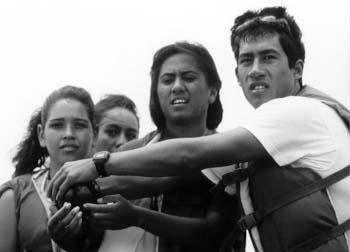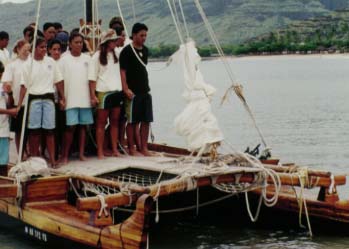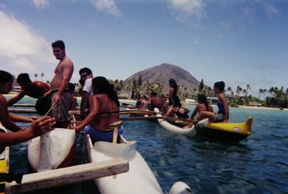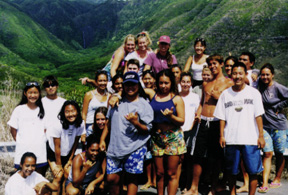 |
|
1996: Exploration Learning Center Launched Photos: Beach at Hakipu‘u; clearing trees for a canoe landing On January 21, 1996, a canoe site among the ironwood trees on the beach at Hakipu'u, was dedicated and blessed. The site, next to Kualoa Regional Park on Kane'ohe Bay, O'ahu, was developed through a a partnership between PVS and the Hakipu'u 'Ohana and Kualoa Ranch. It will house six-man sailing canoes and paddling canoes used in PVS's Exploration Learning Center. The double-hulled canoe Eala, used by PVS for coastal voyaging, is moored at He'eia Kea Pier, Kane'ohe. Kane'ohe Bay has been selected as the primary site for the Exploration Learning Center on O'ahu because of its safe conditions for teaching sailing (a well protected bay with a barrier reef) and its rich cultural, scientific, educational, and community resources. To make use of these resources, PVS is developing education programs which integrate science and culture, and which require students to apply classroom learning to real life challenges and experiences. The purpose of the Center is to excite and challenge students to learn about, respect, and care for the land, sea, and people of Hawai'i and to contribute to the Vision and Mission of PVS. Programs are designed to:
Students from UH Manoa's Center for Hawaiian Studies and Windward Community College, and Wai'anae High School participated in the ELC during the Spring of 1996. Wai'anae Hawaiian Civic Club, Hui Nalu, and Loch Eggers donated sailing canoes for the program. The program is supported by the Hawai'i Community Foundation and Queen's Health Systems. Vision Mission In partnership with other groups, PVS is committed to developing and conducting model educational programs using voyaging to excite and challenge students and their communities to learn about, respect, and care for their natural and social environment. Goals Develop and conduct a voyaging program that prepares students to take responsibility for themselves, their community, and their environment. Forge partnerships with cultural and scientific organizations, government agencies, and community groups to develop and maintain healthy, productive, safe communities. Guiding Hawaiian Values
1996: Project Ho'olokahi-High School Voyaging Program
In partnership with the Department of Education and in conjuction with the statewide sail of Hokule'a, PVS is conducting high school voyaging programs with the voyaging canoe Eala. Project Ho'olokahi aims to integrate cultural and environmental learning on land and at sea and to bring students, family, and community together around the shared value of Malama Hawai'i--caring for our special island home. Voyaging Training Camps, February 3-14, Kualoa Regional Park: Five groups of students will participate in two-day camps to learn the sailing dynamics of a Polynesian canoe and the basics of navigation by the stars as well as how to sail Eala and plan thei r round the island sail. Participating high schools: Castle, Hana (Maui), Kailua, Wai'anae, and Waipahu. Voyaging Around O'ahu I, March 16-22. Sixty select students from four high schools-Castle, Kailua, Wai'anae, and Waipahu-will camp together for a week at Kualoa (Mar. 16-Mar. 20) and at Poka'i Bay in Wai'anae (Mar. 20-Mar. 22). Teams of students will sail Eala around O'ahu, ending in Wai'anae on Mar. 22; students who remain in camp will engage in environmental and cultural learning activities, such as reef walks, valley hikes, lo'i (taro patch) restoration, and fishpond visits. Voyaging Around O'ahu II, April 5-12. Forty students from Wai'anae High School's Marine Science Learning Center will sail around O'ahu in teams, anchoring and camping at various sites around the island. Camp sites will include Ke'ehi Lagoon, Maunalua Bay, Moku o Lo'e (Coconut Island), Kualoa, Kahana, Hale'iwa, and Makaha. Project Ho'olokahi is supported by a grant from the Hawai'i Community Foundation. 1997 Project Ho'olokahi: Inspired Learning In the Spring 1997, the Polynesian Voyaging Society completed the third year of a project funded by the Hawai'i Community Foundation to develop an ocean education program with the Department of Education. Project Ho'olokahi aims to integrate cultural and environmental learning on land and at sea and to bring students, family, and community together around the shared value of Malama Hawai'i;caring for our special island home. The program culminates with a voyage around O'ahu on Eala,a canoe owned by the Wai'anae Hawaiian Civic Club.
Wai'anae Students Steering Eala; photo by Monte Costa Students were asked, anonymously, "Did you Benefit from Project Ho'olokahi? If so, How?" Student 1: Yes, I did benefit from this program very much! It taught me a lot about who I am and how important it is to know about my ancestors and what my heritage is all about. The most lasting effect that I'll have is the time spent on the E'ala and making that sail from Kualoa to Kahana. It was very awesome! What I will take with me in the future is the importance of the aina (land) that we live on, and how we Hawaiians are nothing without it. And how ohana (family) is important. Mostly how to perpetuate our heritage in language and our everyday lives. And especially learning about how the first Hawaiians used the stars to navigate. Student 2: I learned so much about the stars, the tides, preparation of the canoe, plotting routes, chants, and a whole bunch of arts and crafts. This program gave me a chance to meet new people and it taught me to have a greater respect and appreciation for everything. I think the part of the program that will have the lasting effect on me is the actual sail and everything that I was taught. The sail because it was a once in a life time thing and it was simply amazing. It gave me a chance to better my social and communication skills with my crew (team). All the information that I learned will also have a lasting effect on me because it was so interesting. Till this day, I still go outside at night and review the stars. I think I could take a lot of these skills with me in my future. Things like communication skills, respect, team working abilities and many more. This program has even encouraged me to possibly study this in college. Student 3: I think the entire program had a lasting effect on me. I believe that I benefited from the entire program. It has given me cultural awareness. It has taught me what growing up in the Hawaiian way and being Hawaiian was and is all about. It has given me direction in my life and has taught me how to focus on a goal and follow it through, by making sail plans and actually getting to our destinations. It has taught me about effective decision making and weighing out all my options before committing to a decision. This is my second year in the program and I feel that it has helped me to decide what course of study I am going to take in college. I have decided to take up Marine Biology. Being in this program has taught me a lot about how the ocean swells and currents work. It has also taught me how important our oceans are to us and our future. I will take with me the decision making skills, knowledge of the ocean and stars, the cultural awareness and most of all the wonderful memories the program has given me.
Seniors at the Closing Ceremony of Project Ho'olokahi, Poka'i Bay, Wai'anae; Photo by Monte Costa Summer 1998: Center for Marine Sciences In the summer of 1998, in partnership with the Department of Education and the Hawai'i Institute of Marine Biology (HIMB), University of Hawai'i at Manoa, the Polynesian Voyaging Society conducted a 5-week program in Marine Science for 25 students from across the state. In addition to covering the standard DOE Marine Science curriculum, the program had some special goals. It was designed to -be challenging and relevant to important issues concerning Hawai'i's future; -use the ocean and the voyaging canoe as classrooms; -integrate school work with hand-on experiences and applications to actual places and communities in Hawai'i; -involve the families and communities of the students and contribute to their well-being; -explore what makes Hawai'i special and discover ways of preserving that specialness. The following account of the program by participant Kaui Kaho'onei , a junior at Nanakuli High School, appeared in the West Coast Chronicle (September 1998):
SPEBE Students Paddling Out into Maunalua Bay to Transect a Reef
SPEBE Students above Halawa Valley; author Kaho'onei is kneeling on the left. Other Student Comments on SPEBE: "This program has taught me so much-stars, oceanography, teamwork-the ocean has truly been my classroom this summer." "The only way to lean anything is to just go out and do it yourself and that's what we did. Everything was totally hands on and even though it was tough, it was the best!" "I look at things differently now. I look at the ocean and I don't just see a body of water, I see a magical place.I gained a lot of knowledge that I'm able to take with me to the future. And the funny thing is that I had fun doing it. I wanted to learn, I was eager to learn. I recall hearing words like "ohhhh" and "wow." We were interested. Learning was something that we wanted to do. It's not like school where you learn something and forget it a week later. It's something you'll always remember because you're able to apply it to life." "Helping out the communities we visited made me feel good; we let adults know that there are some kids who care and want to help." "I came to the program for the science part but I found myself enjoying the other aspects of it more. This helped me to get a broader view and more respect and appreciation of our oceans. On a scale of 1-10, I give it a perfect 10." "The whole experience had a lasting effect on me. During the first week of life-guarding, we were doing board relays and there was someone who was still finishing when everyone else was done. I know that person was probably shame knowing all eyes were on her. Without hesitation, the whole group got up and joined her in the water. As we finished all together I knew that we had already begun to think of each as family." "The mixture of science and culture made me even more aware of why Hawai'i is so unique and why we need to do all we can to protect and preserve it. I have made so many friends. The mixture of personalities and values was a challenge worth overcoming to make these lasting friendships. This program and summer will always last in my heart and memories. This truly was the best summer I ever had!" PVS wishes to thank all who helped out with the SPEBE Program Kamaki Kanahele and Kauila Clark for welcoming the students to Wai'anae; Dennis Gouveia, Mel Pu'u, Brian Keaulana, and the Westside Hawaiian Lifeguard 'Ohana for sharing their knowledge of the Wai'anae Coast; Glenn Pang, City and County Life Guard for running the lifeguarding certification program; Gordon Grau, Malia Chow, and Greta Aeby of the HIMB for the marine biology curriculum; Sam Gon of the Nature Conservancy for his talk on ahupua'a; Paul Reppun and the Waiahole farmers; 'Aulani Wilhelm, Dave Gulko, and Joanne Kushima of the DLNR; Matt Poepoe and Kekama for teaching the students about Mo'omomi; Les of Halawa, Moloka'i; Patty Lee and Rick Lumpkin of the School of Ocean and Earth Sciences and Technology (SOEST), UH Manoa; Kamuela Chun, Director of the Native Hawaiian Programs for the Community Colleges, who taught the students a name chant for Hokule'a; Lilikala Kame'eleihiwa for allowing us to use a classroom at the Center for Hawaiian Studies; interns and PVS crew members Russell Amimoto, Shantell Ching, Rob Griffin, Terry Hee, Camille Kalama, Heather Mendez, Ka'iulani Murphy, Sarah Parker, Ryan Wong; dorm managers Michelle Kapana-Baird and Gordon Mau, and many others who helped to enhance the education of the students. They were appreciated by all. |



